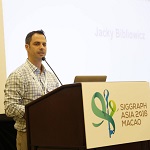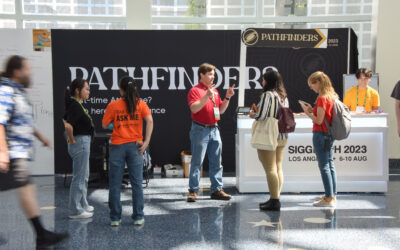Image credit: photo by John Fujii © 2016 ACM SIGGRAPH
Fifty professional and student ACM SIGGRAPH Chapters from all over the world meet year-round to organize and attend events aimed at uniting the global computer graphics community. We sat down with current Chapters Committee Chair Jacky Bibliowicz to better understand the goal of the chapters, member involvement, and what’s in store for the future.
SIGGRAPH: How did you first become involved with the ACM SIGGRAPH Chapters committee?
Jacky Bibliowicz (JB): My involvement began when I was volunteering with the International Resources Committee (IRC). During this time, the Professional & Student Chapters Committee (or, PSCC) was hosting a “logistics fair” at its annual workshop with SIGGRAPH chapter leaders. This event is an opportunity for chapter leaders to connect with different parts of the ACM SIGGRAPH organization and explore solutions to challenges, as well as avenues for collaboration. As an IRC representative, I attended these workshops.
At this point in time, I was not a member of a chapter, as the Toronto Chapter was not active; however, at SIGGRAPH 2012, I met a few other Toronto natives who were interested in rebooting the chapter, and, after the conference, we quickly got to work. We received a charter by November of that year. Due to this effort and my work for the IRC, I was invited to participate in the PSCC face-to-face meeting in March of 2013 and have been a formal part of the Chapters Committee ever since.
SIGGRAPH: What advice would you share with someone who wants to start a professional or student chapter?
JB: I like to think of chapters as organizations in the business of hosting events. Therefore, the more knowledge and experience you have at running events, the better off you’ll be. Leadership, team-building, marketing, and budgeting are all good skills to have, but, above all else, find a good team!
When I started off as chair of the Toronto Chapter, I certainly did not have any experience building an organization; however, I was very fortunate to have a talented team of volunteers! Our vice chair’s artistic talent is evident in our logo and other marketing materials. Our secretary’s resourcefulness led to many industry contacts and connections I did not even think possible—we even had press at our launch event! Our treasurer’s business background is instrumental in keeping track of our finances and producing professional reports. We also had a fantastic founding volunteer who was fabulous at organizing others and keeping our events running smoothly. The Toronto Chapter would not have grown as quickly as it did if it wasn’t for these hardworking individuals. As Chair, I keep the vision and direction of the chapter going, but the team’s work is truly responsible for the chapter’s success.
Logistically, it is also important to start slow when building a chapter. It is typical for excited volunteers to want to do more, but what we’ve learned is that chapter leaders who start taking on too much burn out quickly. I know this personally, as my goal was to do an event every month when the minimum requirement is four events per year. I quickly burned myself—and the team—out, so we took the summer off. This worked for us, and saved us from the fate that many chapters face when they fall apart in their first year.
Finally, make sure you are passionate about ACM SIGGRAPH and the chapter you are starting. Although this sounds like a cliché, it is this passion that will keep you motivated to work through the many challenges that starting and running a chapter will throw at you. And, believe me, they will come!
SIGGRAPH: If someone is skeptical about getting involved with a chapter, should they still join?
JB: If you are excited about computer graphics and interactive techniques, then why wouldn’t you join a chapter? You get to meet other people in your geographic area who are also excited about these topics, watch screenings, listen to local and visiting speakers on a intriguing topics, experience demos, and meet new friends along the way!
And if you don’t feel that your local chapter is putting together events that are of value to you, speak to the chapter leaders and help them create an event you would like to attend. Chapters are always looking for volunteers and will appreciate your help.
SIGGRAPH: What resources are available from ACM SIGGRAPH for professional and student chapters?
JB: One of PSCC’s jobs is to improve existing chapter resources and look for opportunities to provide more. For example, since chapters are always looking for event content, we have a resources to help with that. First, there is the ACM Distinguished Speakers program. Using this program, chapters can invite speakers from other cities to present, and ACM will help cover the travel costs. Additionally, chapters can request the SIGGRAPH Computer Animation Festival Traveling Show from both the North America and Asia conferences to screen at a chapter event. Chapter leaders interested in these programs should contact PSCC for more information, as it changes from year to year.
All chapters are required to have a website to create an online presence for their chapter, rather than just social media. ACM hosts the website and, as of 2018, PSCC also provides a template website that chapters can use to get up-and-running quickly. Chapters are also provided with email lists that they can use to communicate within the leadership team and to their members. As of this writing, PSCC is also piloting a program to provide all chapters with shared cloud storage that each chapter can use to manage its files—all hosted by ACM SIGGRAPH.
Another resource PSCC offers is a traveling streaming kit. Chapters can contact PSCC to request the kit and stream one of their events. This program is still in pilot mode, but we are very excited about the idea of having more chapter event content online!
Finally, although chapters are self-funded, PSCC does have a limited amount of funds that chapters can request to help cover a budget shortfall for a particular event. Chapter leaders are required to provide, among other things, a budget for their event and show where PSCC funds will be used, as well as produce a write-up of the event afterwards. If you’re interested, please contact PSCC for more details.
SIGGRAPH: How do the ACM SIGGRAPH organization and chapters support each other?
JB: ACM SIGGRAPH supports its chapters by promoting chapter activities on the SIGGRAPH website, blog, newsletters, and social media. It also provides the SIGGRAPH Computer Animation Traveling Show for the chapters to screen. Additionally, for the past couple of years, through the Executive Committee’s strategy initiatives, a few projects have been created to support the chapters, which will hopefully have final details worked out in the near future
Chapters support ACM SIGGRAPH by extending the work of the annual conferences. Events put on by chapter volunteers provide attendees experiences similar to the ones they would experience at a conference. Being year-round organizations, chapters provide these experiences throughout the year and at many locations. Through their events, chapters educate and generate excitement in the public for computer graphics and interactive techniques, promote ACM SIGGRAPH and its conferences, and enrich the SIGGRAPH family. Ultimately, chapters create a space that enables more people to tell their stories.
SIGGRAPH: Can you share any future plans you have for chapters?
JB: There is an initiative that I’ve been working on since I became chair of PSCC, and it has proven to be harder to accomplish than what I initially imagined. We currently have a rigorous process of accepting new chapters into the ACM SIGGRAPH family. Once the chapter receives a charter, chapter leaders receive a lot of information detailing the appropriate regulations and procedures to follow in order to stay in good standing. What we don’t have, and what I would like to assemble, is a collection of tips and best practices on how to run a chapter, collected from the many years of experience current chapter leaders have acquired. I believe this “Chapters Leader Training Manual” would be truly beneficial for new chapters starting out, and I intend to put more resources toward creating this document in the near future.
For more information about student and professional chapters, click here. Questions? Contact the ACM SIGGRAPH Professional & Student Chapters Committee.
Jacobo (Jacky) Bibliowicz is a Principal Research Scientist at Autodesk Research, which he joined full-time in June, 2012. Originally from Bogotá, Colombia, Jacky received a B.S. in Applied and Engineering Physics and a M.S. in Architectural Science from the Program of Computer Graphics, both at Cornell University, before moving to Canada to pursue further graduate work at the University of Toronto.




